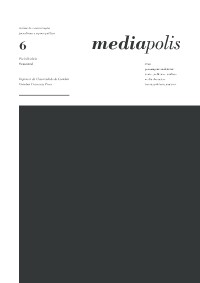Please use this identifier to cite or link to this item:
https://hdl.handle.net/10316.2/93518| DC Field | Value | Language |
|---|---|---|
| dc.contributor.author | Dias, Luís Augusto Costa | - |
| dc.date.accessioned | 2018-03-05T16:07:43Z | |
| dc.date.accessioned | 2020-10-04T07:02:50Z | - |
| dc.date.available | 2018-03-05T16:07:43Z | |
| dc.date.available | 2020-10-04T07:02:50Z | - |
| dc.date.issued | 2018 | - |
| dc.identifier.issn | 2183-5918 | - |
| dc.identifier.issn | 2183-6019 (PDF) | - |
| dc.identifier.uri | https://hdl.handle.net/10316.2/43606 | - |
| dc.description.abstract | O texto parte da perspetiva, já anteriormente estudada, de que a imprensa de massas em Portugal − que tem em 1865, com a fundação do Diário de Notícias, o seu ano zero e, a partir de 1881, com o jornal O Século a sua expansão imparável – transformou a I Grande Guerra, de 1914-1918, na primeira grande guerra mediática. À apoteose da guerra não faltou o recurso à ficção, no sentido literário − aquilo a que o jornalista Mário de Almeida então chamou a “literatura da guerra”, como um “campo baldio” pronto a “passa[r]-lhe a charrua por cima”, e que designo por ficções de guerra. O corpus textual de que falo, publicado na revista Ilustração Portuguesa (pertencente ao império d’O Século), num conjunto que não perfez quatro dezenas de textos, ocupou um arco cronológico que se estendeu, com decrescente regularidade, de 1 de fevereiro de 1915 a 28 de agosto de 1916. A iniciativa partiu, salvo um ou outro autor à procura de um lugar nas letras, de um campo jornalístico ainda de paredes meias com a escrita ficcional ou teatral – ou, como esperava o interlocutor de um conto de Natal na guerra: “Meta-lhe você um bocado de literatura e aí tem um assunto para um conto de Natal...” Não tanto pelos temas, são as personagens que, pela sua resolução, pelo esforço, pelo sacrifício ou pela glória moralizadora, vão ao encontro do mercado das emoções criado pela propaganda mediática. | por |
| dc.description.abstract | The article starts from the perspective, elsewhere studied, that the mass media in Portugal − which has its zero year in 1865, with the foundation of Diário de Notícias, and since 1881, with the appearance of the newspaper O Século, its unstoppable expansion − transformed the Great War of 1914-1918 into the first mediatic war. The apotheosis of the war did not lack the use of fiction, in the literary sense, what the young journalist Mário de Almeida then called a «literature of war» as a «vacant field» ready to «pass the plough above», and which I designate as war fictions. From this fictional representation came a textual corpus, published in the magazine Ilustração Portuguesa (belonging to the mediatic empire of O Século), in a set that did not complete four dozen texts in a chronological arc that extended, with decreasing regularity, from 1 February 1915 to August 28, 1916. Except for one or another author looking for a place in the literary field, the initiative came from a new and specific journalistic field in statement process, but still in half walls with the literary writings. These war fictions were intended to feed all the sensationalism of war, plus the emotion that the creation of characters could credibly lend to the climate of the conflict, that is to say a greater efficacy in staging the real, as was expected by the interlocutor in a story about a Christmas in war: “Give it some literature and there’s a subject for a Christmas tale ...” Not so much for the interest of the fictional themes or narrative strategies, are the characters who, even if stereotyped and sometimes ill-defined, meet the emotions market created by the mediatic propaganda, with his example of personal determination, effort, sacrifice or moralizing glory. | eng |
| dc.language.iso | por | - |
| dc.publisher | Imprensa da Universidade de Coimbra | - |
| dc.rights | open access | - |
| dc.subject | I World War | eng |
| dc.subject | O Século | eng |
| dc.subject | Ilustração Portuguesa | eng |
| dc.subject | journalism and literature | eng |
| dc.subject | war fiction | eng |
| dc.subject | I Grande Guerra | por |
| dc.subject | O Século | por |
| dc.subject | Ilustração Portuguesa | por |
| dc.subject | jornalismo e literatura | por |
| dc.subject | ficção de guerra | por |
| dc.title | Personagens inventadas: jornalismo e ficção na I Grande Guerra mediática (1914-1918) | por |
| dc.title.alternative | Invented characters: journalism and fiction in the First (mediatic) World War (1914-1918) | por |
| dc.type | article | - |
| uc.publication.collection | Mediapolis n.º 6 | - |
| uc.publication.firstPage | 41 | - |
| uc.publication.issue | 6 | - |
| uc.publication.lastPage | 59 | - |
| uc.publication.location | Coimbra | - |
| uc.publication.journalTitle | Mediapolis: revista de comunicação, jornalismo e espaço público | - |
| dc.identifier.doi | 10.14195/2183-6019_6_3 | - |
| uc.publication.orderno | 3 | - |
| uc.publication.area | Artes e Humanidades | - |
| uc.publication.manifest | https://dl.uc.pt/json/iiif/10316.2/93518/265279/manifest?manifest=/json/iiif/10316.2/93518/265279/manifest | - |
| uc.publication.thumbnail | https://dl.uc.pt/retrieve/12098894 | - |
| item.grantfulltext | open | - |
| item.fulltext | With Fulltext | - |
| Appears in Collections: | Mediapolis | |
Files in This Item:
| File | Description | Size | Format | |
|---|---|---|---|---|
| personagens_inventadas.pdf | 3.02 MB | Adobe PDF |  |
Items in DSpace are protected by copyright, with all rights reserved, unless otherwise indicated.
